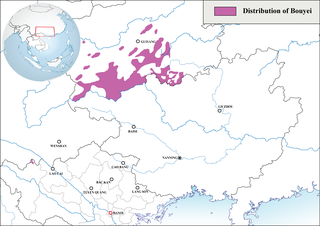Related Research Articles

The Bouyei language is a language spoken by the Bouyei ethnic group of Southern Guizhou Province, China. Classified as a member of the Northern Tai group in the Tai language branch of the Tai–Kadai language family, the language has over 2.5 million native speakers and is also used by the Giay people in some parts of Vietnam. There are native speakers living in France or the United States as well, which emigrated from China or Vietnam. About 98% of the native speakers are in China.
Gelao is a Kra language in the Kra–Dai language family. It is spoken by the Gelao people in southern China and northern Vietnam. Despite an ethnic population of 580,000, only a few thousand still speak Gelao in China. Estimates run from 3,000 in China by Li in 1999, of which 500 are monolinguals, to 7,900 by Edmondson in 2008. Edmondson (2002) estimates that the three Gelao varieties of Vietnam have only about 350 speakers altogether.
The Pakanic languages constitute a branch of two Austroasiatic languages, Bolyu and Bugan. They are spoken in Guangxi and Yunnan provinces of southern China. Mang was formerly included, but is now considered by Paul Sidwell to form its own separate branch within Austroasiatic.
The Sui language is a Kam–Sui language spoken by the Sui people of Guizhou province in China. According to Ethnologue, it was spoken by around 300,000 people in 2007. Sui is also unique for its rich inventory of consonants, with the Sandong (三洞) dialect having as many as 70 consonants. The language also has its own script, known as "Shuishu" (水書) in Chinese, which is used for ritual purposes.
Qabiao, Pu Peo or sometimes Laqua is a Kra language spoken by the Qabiao people in northern Vietnam and Yunnan, China. Alternative names for Qabiao include Kabeo, Ka Beo, Ka Bao, Ka Biao, Laqua, Pubiao and Pen Ti Lolo. The meaning of the name "Qabiao" is unknown.
The Kam–Sui languages are a branch of the Kra–Dai languages spoken by the Kam–Sui peoples. They are spoken mainly in eastern Guizhou, western Hunan, and northern Guangxi in southern China. Small pockets of Kam–Sui speakers are also found in northern Vietnam and Laos.
The Kra languages are a branch of the Kra–Dai language family spoken in southern China and in northern Vietnam.
Jiamao is a divergent Kra-Dai language spoken in southern Hainan, China. Jiamao speakers' autonym is 1.
The U language or P'uman, is spoken by 40,000 people in the Yunnan Province of China and possibly Myanmar. It is classified as an Austroasiatic language in the Palaungic branch. In China, U speakers are classified as ethnic Bulang.
Laha is a Kra language spoken by approximately 1,400 people out of a total population of 5,686 Laha. It is spoken in Lào Cai and Sơn La provinces, Vietnam. Laha dialects had been documented in 1986 by Russian linguists and in 1996 by American linguist Jerold A. Edmondson. Many Laha can also converse in the Khmu language, and Laha-speaking areas also have significant Black Thai, Kháng, Ksongmul, and Hmong populations.
The Buyang people are an officially unrecognized Kra ethnic group living in Wenshan Prefecture, Yunnan and Napo County, Guangxi in China. They are closely related to the Laha, Qabiao, Gelao, and Lachi. The Buyang language is spoken, although many Buyang are now shifting to Zhuang and Southwestern Mandarin. In Yunnan, the Buyang are classified by the Chinese government as Zhuang, while they are classified as Yao in Guangxi.
The Biao language is a Kra–Dai language spoken in southwestern Huaiji County and Fengkai County, Zhaoqing, Guangdong. Autonyms are and.
Va is a pair of Angkuic languages spoken in Mojiang Hani Autonomous County, Yunnan, China. Although the Va autonym is, the language is not Wa, and neither does it belong to the Waic language subgroup. Rather, Va constitutes a separate subdivision within the Angkuic languages.
The Lisoish languages are a branch of the Loloish languages proposed by Ziwo Lama (2012) that includes Lisu and several of the Yi languages. David Bradley (1997) considers Lisoish languages to be part of the Central Loloish branch.

The Northern Tai languages are an established branch of the Tai languages of Southeast Asia. They include the northern Zhuang languages and Bouyei of China, Tai Mène of Laos and Yoy of Thailand.
Biao Min, or Biao-Jiao Mien, is a Hmong–Mien language of China. The two varieties, Biao Min and Jiaogong Mian, are evidently not mutually intelligible.
A'ou (阿欧方言) or Red Gelao (红仡佬语) is an endangered Gelao language spoken by fewer than 100 people in Guizhou, China. Only the Hongfeng (红丰) and Bigong (比贡) dialects are still spoken, each with only a few dozen speakers.
Awu, is an unclassified Loloish language of Yunnan, China. It is spoken in Yuanyang County, Yunnan, China, including in the village of Xiaopingzi 小坪子, Daping Township 大坪乡.
Caijia is an endangered Sino-Tibetan language spoken in an area centred on Bijie, in the west of the Chinese province of Guizhou. It was first documented by Chinese researchers in the 1980s. It has been described by different authors as a relative of Bai or an early split from Old Chinese. The autonym is. According to Lu (2022), Caijia speakers in Xingfa 兴发乡, Hezhang County refer to their language as.

The Longjia are an unofficially recognized ethnic group of western Guizhou province, China. They are officially classified as Bai by the Chinese government.
References
- 1 2 3 4 Hsiu, Andrew. 2017. Hezhang Buyi: a highly endangered Northern Tai language with a Kra substratum . doi : 10.5281/zenodo.1249176
- Hsiu, Andrew. 2013. “Shui” varieties of western Guizhou and Yunnan . Presented at the 46th International Conference on Sino-Tibetan Languages and Linguistics (ICSTLL 46), Dartmouth College, Hanover, New Hampshire, United States, August 7–10, 2013 (Session: Tai-Kadai Workshop). doi : 10.5281/zenodo.1127798
- Data sources
- Hsiu, Andrew. 2017b. Hezhang Buyi (Dazhai) audio word list . Zenodo. doi : 10.5281/zenodo.1122579
- Hsiu, Andrew. 2017c. Hezhang Buyi (Tiejiang) audio word list . Zenodo. doi : 10.5281/zenodo.1122581